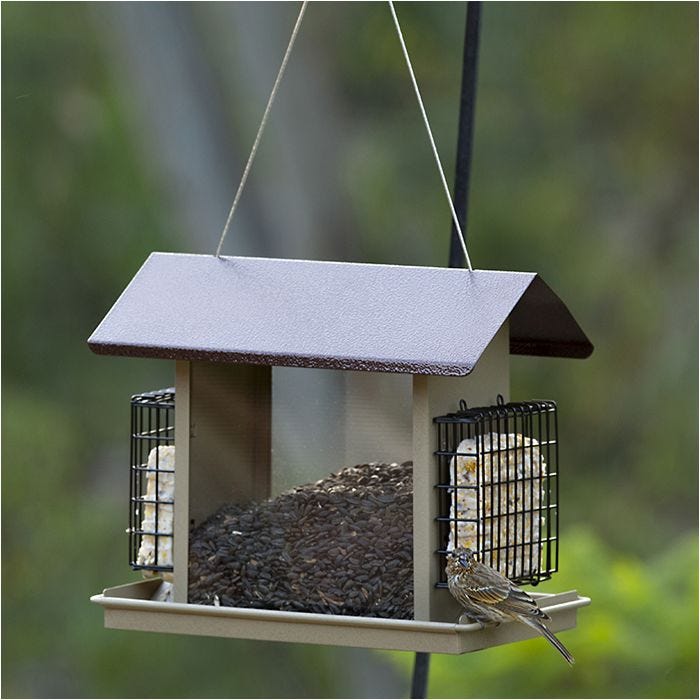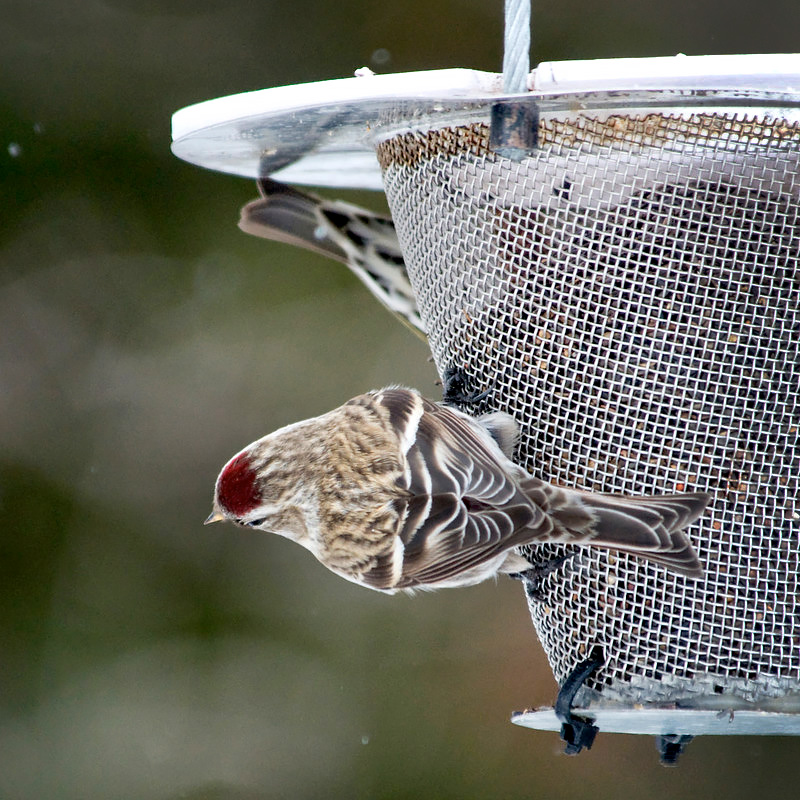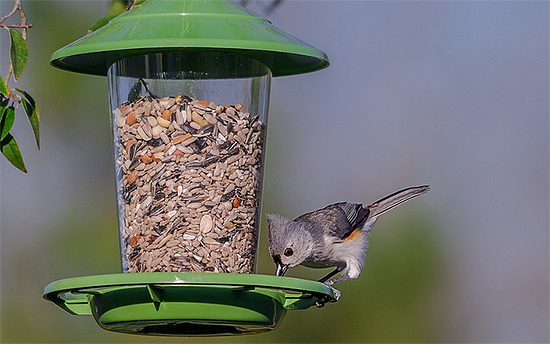Feeding suet to birds is an effective way to attract a diverse range of feathered friends to your feeders. Suet, which refers to any solid animal or vegetable fat at room temperature, is a high-energy food that offers essential fat and calories during migration and winter. This tempting treat appeals to various avian species, including woodpeckers, chickadees, nuthatches, titmice, and jays. To ensure the birds’ convenience, specialized suet feeders or spreading suet on trees can be utilized. Additionally, upside-down suet feeders are particularly handy in preventing larger birds from depleting all the suet supply. While commonly offered in the winter, suet can be fed year-round with proper precautions. It is crucial to store suet correctly and remove any old or moldy suet from the feeders to maintain the birds’ well-being. For those with a creative touch, homemade suet can be crafted using various ingredients and flavors, providing a delightful culinary experience for both the birds and bird enthusiasts.
:max_bytes(150000):strip_icc()/what-birds-eat-suet-385831-hero-d4dfa9154d2445a9ac2860015b2c5779.jpg)
Benefits of Feeding Suet to Birds
Feeding suet to birds offers a range of benefits that make it a popular choice among bird enthusiasts. One of the primary advantages of suet is its ability to attract a variety of birds to your feeders. The high energy and nutrition content of suet also make it an excellent food source for birds, particularly during migration and the winter months. Additionally, suet can appeal to different bird species, allowing you to attract a diverse array of feathered friends to your backyard.
Attract a Variety of Birds
One of the most enticing aspects of feeding suet to birds is the opportunity to attract a wide variety of avian species to your feeders. Suet’s rich and enticing aroma acts as a homing beacon for birds, from woodpeckers to chickadees, nuthatches to titmice, and even jays. By providing suet, you can transform your backyard into a bustling bird sanctuary, where different species gather to feed and entertain both you and your family.
Provide High Energy and Nutrition
Suet is a high-energy food that offers an abundance of fat and calories for birds. This is particularly beneficial during migration and winter when birds require substantial energy reserves to survive long journeys or harsh weather conditions. By offering suet, you give birds a much-needed energy boost, helping them sustain their flights or stay warm during cold winter nights. The nutritional content of suet makes it an essential food source for birds, contributing to their overall health and well-being.
Support Birds During Migration and Winter
Migration and winter pose significant challenges for birds, as they navigate long distances or endure frigid temperatures. Feeding suet can play a crucial role in supporting these birds during these challenging times. The high fat content of suet helps birds maintain their energy levels, allowing them to continue their migratory journeys or withstand the cold winter months. By offering suet, you become a vital source of nourishment and support for these feathered travelers, ensuring their survival and well-being.
Appeal to Different Bird Species
Suet’s appeal extends beyond its high energy and nutritional value. Its distinct texture and taste make it an attractive option for a wide range of bird species. From small woodland birds to larger and more aggressive ones, suet can entice a diverse assortment of feathery visitors to your feeders. This variety adds an exciting element to birdwatching, as you may discover new and unexpected species frequenting your backyard, each with their own unique behaviors and characteristics.
Methods of Feeding Suet
Feeding suet to birds can be done in various ways, depending on your preferences and the types of bird species you wish to attract. Here are some popular methods for offering suet to feathered friends.
Using Specialized Suet Feeders
Specialized suet feeders are specifically designed to hold and dispense suet for birds. These feeders typically feature wire cages or mesh compartments that securely hold suet while allowing birds to peck at it. This design prevents the suet from falling to the ground and ensures that birds can eat it without much difficulty. Specialized suet feeders come in different shapes and sizes, allowing you to choose the one that best suits your needs and the preferences of the birds in your area.
Spreading Suet on Trees
Another method of feeding suet is by spreading it directly on trees. This technique mimics the natural way birds would obtain suet from tree barks in the wild. Simply apply a generous amount of suet onto tree trunks or branches, making sure to place it where birds can easily access it. This method is particularly beneficial for attracting woodpeckers and other tree-dwelling birds that prefer feeding while clinging to vertical surfaces. It also provides an opportunity to observe birds in their natural habitat, as they exhibit their impressive acrobatic skills while indulging in the suet.
Upside-Down Suet Feeders for Larger Bird Control
If you find that larger birds, such as starlings or grackles, dominate your suet feeders, you can opt for upside-down suet feeders. These feeders are designed to deter larger birds by requiring them to hang upside-down to access the suet. Since larger birds are less adept at hanging upside-down, this type of feeder allows smaller, clinging birds to feed undisturbed. Upside-down suet feeders are an effective solution for those who want to attract specific bird species while preventing larger birds from depleting the suet too quickly.

Seasonal Considerations
While suet is often associated with winter feeding, there are reasons to consider offering it year-round. Here’s what you need to know about suet feeding during different seasons.
Suet Feeding in Winter
Winter is a critical time for birds, as they must endure harsh weather conditions while facing limited food sources. Feeding suet during winter can provide birds with the necessary energy to stay warm and survive the cold temperatures. The high fat content of suet helps birds maintain their body heat, while the plentiful calories fuel their metabolic needs. By offering suet in your backyard during winter, you provide a lifeline for birds and ensure that they have the resources to withstand the harshest of seasons.
Feeding Suet Year-Round
Although suet is commonly associated with winter, offering it throughout the year can be beneficial for both birds and birdwatchers. While birds may not require the same level of energy during other seasons, suet continues to provide them with a convenient and easily digestible food source. In spring, suet can support birds during nesting and breeding, providing them with the necessary nutrients to raise their young. During the summer, when natural food sources may dwindle, suet can be a reliable supplement to keep birds nourished. By maintaining a year-round suet feeding regimen, you create a haven for birds, ensuring their well-being no matter the season.

Proper Storage and Maintenance
To ensure the quality and effectiveness of the suet you provide, proper storage and maintenance are essential. Consider the following guidelines for storing and maintaining suet feeders.
Storing Suet Correctly
Suet should be stored properly to maintain its freshness and prevent spoilage. Since suet is solid at room temperature, it’s crucial to store it in a cool and dry location. Avoid exposing suet to direct sunlight or high temperatures, as this can cause it to melt or turn rancid. It’s best to store suet in an airtight container or the original packaging, away from moisture and pests. By taking these precautions, you can ensure that the suet retains its nutritional value and remains appealing to the birds you wish to attract.
Removing Old or Moldy Suet
Regularly inspect your suet feeders for any signs of old or moldy suet. Moldy suet can be harmful to birds and should be promptly removed from the feeder. Dispose of any spoiled suet properly, ensuring that birds cannot access it. Clean the feeder thoroughly before refilling it with fresh suet to maintain a healthy feeding environment. By monitoring the quality of the suet and maintaining a clean feeding station, you provide birds with a safe and reliable food source.

Homemade Suet Recipes
For those who enjoy do-it-yourself projects, making homemade suet blocks or balls can be a fun and rewarding endeavor. Here’s what you need to know to create your own suet recipes.
Ingredients for Homemade Suet
Homemade suet recipes can incorporate various ingredients to cater to specific bird species and their dietary needs. A basic homemade suet recipe typically includes rendered animal or vegetable fat, such as beef suet or vegetable shortening, mixed with other ingredients. Common additions to suet recipes include birdseed, cornmeal, oats, and peanut butter. These ingredients offer additional nutrients and textures that can be appealing to different bird species.
Flavor Variations
One of the advantages of making homemade suet is the ability to experiment with different flavors. You can customize your suet by adding ingredients such as dried fruits, nuts, or even spices like chili powder. However, it’s essential to be mindful of which flavors are safe for birds and which may be harmful. Avoid using additives that are high in sodium, artificial sweeteners, or any ingredient that can be toxic to birds. It’s best to consult reputable birding resources or consult with local experts to ensure that your flavor variations are safe and appealing to the birds in your area.
Creating Suet Blocks or Balls
Once you have prepared your homemade suet mixture, you can shape it into blocks or balls for easy feeding. Use molds or containers to shape the suet mixture and allow it to solidify. You can then hang the suet blocks or balls using twine or place them directly on feeding platforms or specialized suet feeders. Homemade suet provides a creative and economical way to offer birds a nutrition-packed treat, all while adding a personal touch to your bird feeding routine.
Feeding suet to birds is a rewarding experience that allows you to connect with nature while providing essential resources for feathered visitors. By understanding the benefits of suet, different feeding methods, seasonal considerations, storage and maintenance practices, and even homemade suet recipes, you can create a bird-friendly environment that attracts a diverse range of species. So, grab a suet feeder, fill it with your preferred suet, and let the delightful sights and sounds of birds enhance your backyard.

Leave a Reply